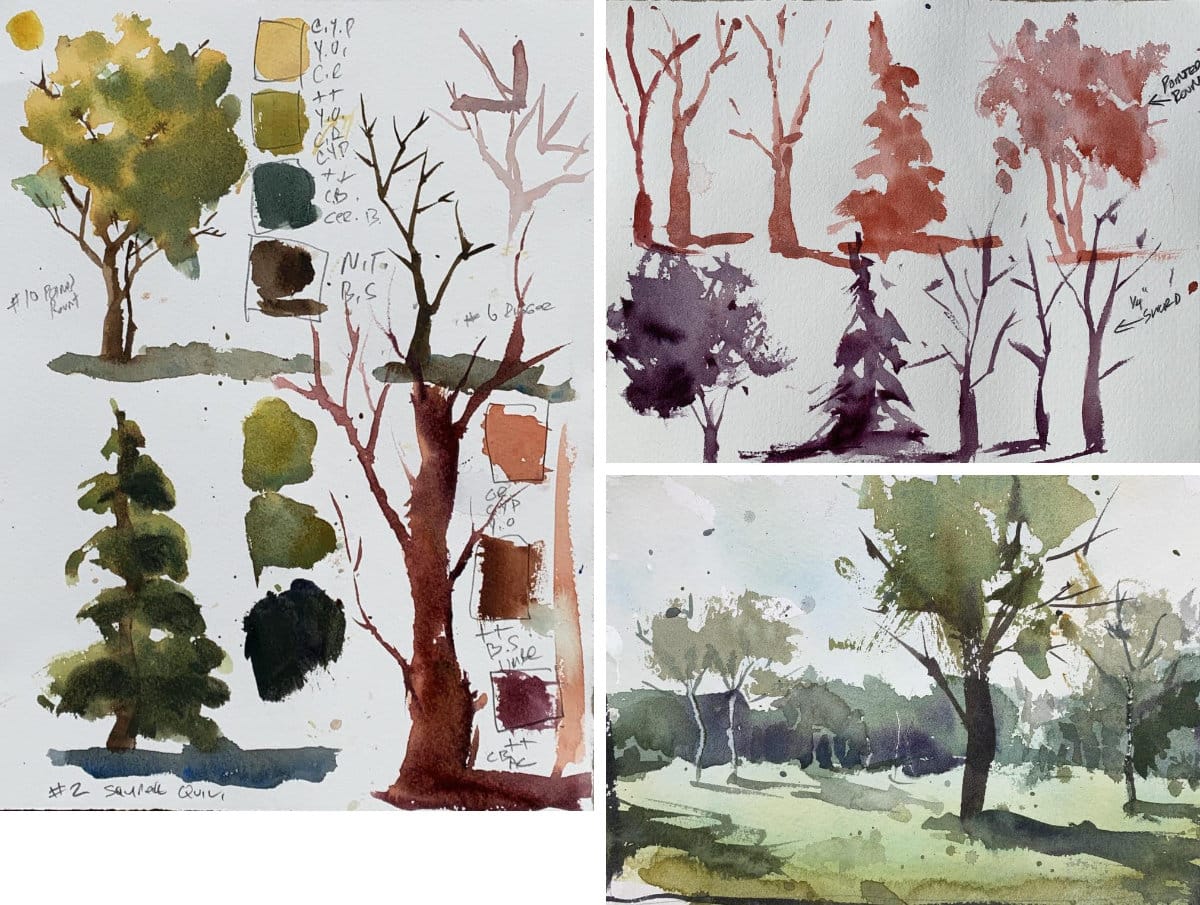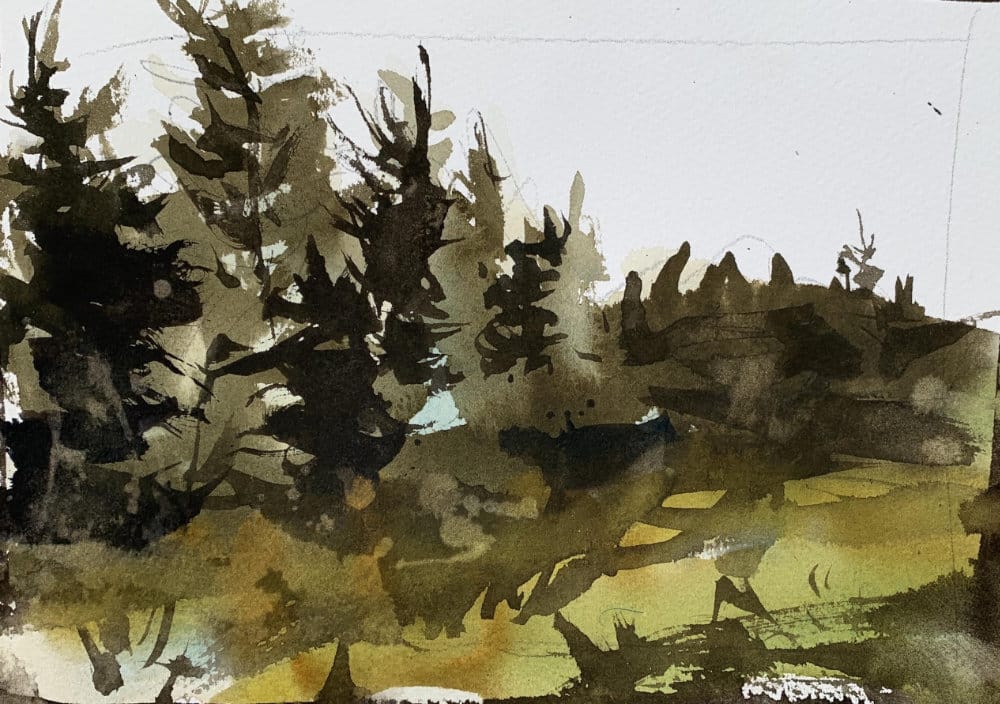Free Watercolor Landscape Workshop - Skies, Trees, Grass & Rocks
My mom's passion for ballroom dancing transferred to me in the studio. This watercolor landscape workshop aims to do the same - sharing genuine enthusiasm for painting natural elements.

This free watercolor landscape workshop course reminds me of a very fond memory. My mom was a professional ballroom dance instructor. In my late 20s, she encouraged me to try it, and I fell in love with dancing - even met my wife there. The real gift was sharing my mom's passion and understanding how enthusiasm transfers from teacher to student.
That experience shaped how I approach teaching watercolor landscapes. Want to take your watercolor landscapes to the next level? In this 5.5-hour, no-signup workshop, I'll walk you through my complete process for painting landscape elements - skies, trees, grass, and rocks - in a loose, expressive style.
You'll get step-by-step video lessons covering individual landscape components rather than complete paintings. This approach lets you build a vocabulary of techniques you can mix and match in your own work. Whether you're a beginner or experienced painter, you'll come away with new methods for tackling any landscape subject.
My hope is that my excitement for watercolor landscape painting transfers to your artistic journey the same way my mom's passion for dance changed my life
👉 Want step-by-step lessons? Visit the Watercolor Hub for tutorials and free courses.
How to Use This Course
This isn't meant to be absorbed in one sitting. With nearly 5-hours of video content it's best you take it in chunks, skies one day, trees the next. This way you're build the watercolor landscape foundations without getting overwhelmed. Bookmark it and come back. Each section is timestamped, so scroll down to see images and other info.
- Watercolor supplies - scroll down to bottom to see my toolbox
- Tips for painting various sky environments
- Trees painting techniques using multiple brushes
- Grass and ground plane elements
- Rocks and stones with various shapes
- Watch the foundation lessons first (Color Mixing, Observation, Values)
- Practice each challenge before moving forward
- Pause the video to work, then return when ready
- Use the written breakdown below as your roadmap and reference, each lesson is timestamped.
- Bookmark your progress for easy return
Watch the Full Workshop Here
Watercolor landscape painting workshop video
Section 1 – Best Watercolor Materials & Workspace Setup (0:00)
Before diving into painting, we’ll start by setting the table for success. You’ll see exactly what materials I use, how I set up my workspace for maximum efficiency, and how the “finger test” helps you mix the perfect paint consistency every time.
Before we dive in, I’ll show you:
- My essential watercolor materials for landscapes
- How I organize my workspace for efficiency
- The “Finger Test” for mixing the right paint consistency every time

Section 2 – Painting Skies in Watercolor (21:23)
The sky sets the mood for any landscape painting. In this section, we’ll cover techniques that range from simple gradients to dramatic storm clouds, all while keeping the process approachable for beginners.
You’ll learn eight different sky techniques to set the mood in your landscapes:
- Simple gradated wash
- Gradated wash with cumulus clouds
- Multi-layered sky
- Soft sunset
- Winter sky with cool light
- Negative space sky
- Approaching storm sky
- Nocturnal sky
We’ll study Master watercolor painters and how they used these techniques.

Section 3 – Painting Trees in Watercolor (2:00:37)
Trees can make or break a landscape. Here, you’ll learn how to suggest foliage and structure without overworking, using brushwork and edges to create believable, lively trees.
- Tree Techniques 101: choosing the right brush and controlling edge quality
- Using bristle brushes for texture
- Wet-in-wet tree shapes
- Winter tree branches
- Birch tree demo
- Palm tree demo
- Scratch techniques for highlights and fine branches

Section 4 – Painting Grass in Watercolor (4:11:15)
Grass is all about texture and depth. This section covers methods for creating grass that feels alive, whether you want fine details or a looser impression.
- Fine detail grass
- Splattering for texture
- Creating grass with shadows & negative space

Section 5 – Painting Rocks in Watercolor (4:52:30)
Rocks give structure and grounding to a landscape. You’ll learn how to use layering, wet-in-dry techniques, and color variation to create realistic forms without stiffness.
- Field rocks
- Round boulders
- Layering & wet-in-dry texture work
- Master examples of rock composition
Assignments & Practice
Throughout the course, I’ll give you simple assignments to help reinforce each skill, so you can build a strong toolkit for painting landscapes from imagination or reference.
Continue Learning
👉 Next stop: check out my Free Watercolor Painting Course or browse the Watercolor Tutorials Hub to keep building your skills.
👉 Follow me on Pinterest for daily watercolor inspiration!
If you enjoy these kinds of raw insights and loose watercolor demos, you’ll feel right at home here. Subscribe to Crafted by Robert and follow along as I share painting inspiration, tips, and behind-the-scenes stories straight from my garage studio. 👉 Subscribe to Crafted by Robert
Watercolor Gear
Here are the materials I use all the time and have for decades. I only buy from Blick Art but feel free to shop where you prefer.
Recommended Watercolor Materials
-
Holbein Professional Watercolor Paints – 8 Essential Hues
Yellow Ochre, Cadmium Lemon Yellow, Ultramarine Blue, Cerulean Blue, Alizarin Crimson, Cadmium Red Light, Neutral Tint, Burnt Sienna -
Fabriano Artistico Watercolor Paper – 140lb Cold Press
Buy full sheets and cut into quarter sheets for best value -
Silver Jumbo Wash Brush
Great coverage, excellent quality for the price -
Princeton Neptune Point Rounds (No. 12 & 6)
Reliable and affordable detail & wash brushes -
Princeton Neptune Dagger (1/2")
Versatile size for lines, edges, and detail work -
Masterson Aqua Pro Palette
Durable, with deep wells for generous mixing space -
Gator Board
Lightweight, long-lasting painting support board -
Holbein White Gouache
Optional for highlights and fine details - Miscellaneous: plastic water containers, paper towels, masking tape
This post contains affiliate links. If you make a purchase through these links, I may earn a commission at no extra cost to you.




